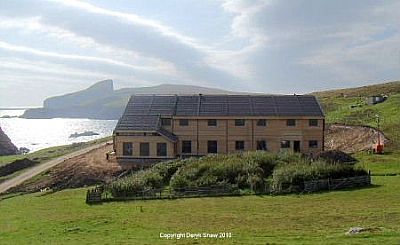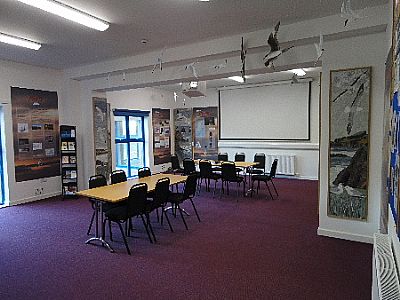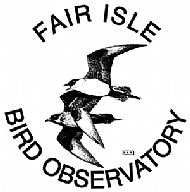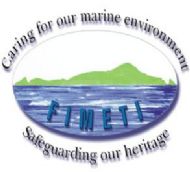Fair Isle Research Facilities
RESEARCH FACILITES AT FAIR ISLE BIRD OBSERVATORY

Photo: Fair Isle Bird Observatory and Guesthouse 2011. Copyright Deryk Shaw.
PLEASE SEE FAIR ISLE BIRD OBSERVATORY WEBSITE FOR LATEST INFORMATION AND UPDATES.
Fair Isle Bird Observatory, established in 1948, has undertaken ornithological research from the very beginning with the seabird element being formalised through a monitoring programme as part of the JNCC nationwide Seabird Monitoring Programme from 1986. During that entire period the Observatory has encouraged and welcomed independent research, and scientists have used the facility through the Observatory’s 62 year history.

Research interest, particularly relating to seabirds, has grown in recent years – partly encouraged by the long-term seabird and allied sets of data available. For the first 20 years facilities were challenging, as the Bird Observatory was housed in a series of Nissen huts left over from the Second World War.
A new purpose-built building in 1969 improved facilities considerably but the inevitable wear and tear on a 40 year old building led to it being replaced by a complete new build in 2009-2010.
Unfortunately, due to a major fire in March 2019, the following facilities were unavailable until the Bird Observatory had been completely re-built and re-opened during 2025.
Please see FAIR ISLE BIRD OBSERVATORY & GUESTHOUSE WEBSITE for latest information and updates regarding its current accommodation and research facilities.
Aware of the growing interest, and importance of research, the new bird observatory building, ‘The Lodge’, was designed to incorporate a number of specific features – including dedicated space for scientists and their field research needs.

Photo: Fair Isle Bird Observatory’s new Interpretive Room & Conference facilities. Copyright FIBOT.
Because of its desire to offer the best in modern facilities, Fair Isle Bird Observatory Trust was faced with a huge financial challenge.
A major fund-raise by FIBOT and its supporters – including the island community – led to the £4 million required being found. This came from public and private subscription. This is a major commitment by FIBOT and society to maintain this important island facility and it seems appropriate therefore that society recoups that investment in programmes and activities for the common good.
The Scottish Government has identified Demonstration and Research as a common good for Scotland and the UK, through the MPA network. In 2011, ten scientists have already confirmed that they will be using the research facility, amounting to just short of 500 research/days. The designation of Fair Isle as a Demonstration and Research MPA site will encourage further use of the facility by scientists.
In addition to 12 other bedrooms, FIBOT currently makes available up to 4 twin rooms and a dedicated office/work area for researchers.
Integral to the new building are a large conference room, visitor centre and modern interpretation facilities with the emphasis on information provision and dissemination of scientific results.
Ringing facilities and demonstrations, a ranger service supported by Scottish Natural Heritage and making a range of subjects, particularly the natural history of the isle, accessible to the general public are mainstay activities open to residents, visitors and islanders alike. Visiting researchers are encouraged to disseminate their findings to the wider public through poster displays and talks.
As a footnote, an increased flow of visitors of all interests and disciplines – as a justification from the public spend – will only be achieved if the ecosystem is maintained in a healthy, fully functioning state. Currently, with failing seabird populations and declines in fish stocks, the marine environment cannot be considered in favourable condition.
Fair Isle Bird Observatory scientific research promotions
FIBO has established ornithological scholarships to promote more research on birds, and especially seabirds.
Extract from FIMETI Newsletter no 12, March 2015 (page 20).
Scientific research
The following summary highlights the wide range of scientific activities, terrestrial as well as marine. It demonstrates the high level of research already in place, setting a baseline for expansion of studies on the marine environment planned as part of the MPA development. The argument in favour of Fair Isle and its Bird Observatory as a Demonstration and Research site becomes even more powerful.
Seabird monitoring by FIBO as part of the national Seabird Monitoring Programme, begun in 1986 and coordinated by the UK’s Joint Nature Conservation Committee, remains a key aspect of monitoring work on the isle.
The Fair Isle Meteorological Station continues to send full data to the UK Meteorological Office. For many years the data have been collected assiduously by islander Dave Wheeler, but now to ensure continuity into the future automatic data recorders have been installed at the Fair Isle Station and in North Haven for sea surface data.
Other ongoing research activities include the RSPB-led Future of the Marine Atlantic Environment (FAME) project researching into foraging patterns of Fair Isle seabirds; the long-term investigation into the genetics and ecology of Fair Isle starlings Sturnus vulgaris under the leadership of Dr PGH Evans (Bangor University) and Prof. Jane Reid of Aberdeen University; and the investigation into disease and mortality amongst birds from systematically collected casualties provided to veterinarian Jason Waine for autopsy. DNA-based studies have been initiated in partnership with Professor Martin Collinson of Aberdeen University. The study is already shedding new light on the identity, taxonomy and origins of some of Fair Isle’s vagrants. Prof. Collinson is a leading exponent in this field.
An important development has been the establishment of a research post to analyse the huge FIBO ornithological dataset, in a partnership between the University of Aberdeen and the Bird Observatory and sponsored by FIBOT. Will Miles, a former staff member at the Bird Observatory with an intimate knowledge of its workings and the isle, was appointed to the post. He is already making great strides in the analysis. The study will not only place the results of 60 years’ endeavour into the public domain but also help to formulate a focused, rigorous programme for future FIBO research.
FIBO also makes full use of its research facility by encouraging and sponsoring visiting researchers undertaking scientific studies.
Though birds remain the main interest of the Bird Observatory, FIBO long-term monitoring is maintained for Fair Isle cetaceans and migrant butterflies. It is also one of three moth monitoring stations on the isle, with the records provided to the National Moth Recording Programme (www.mothscount.org).
More information about Fair Isle Bird Observatory's ongoing Ornithological Monitoring and Seabird Research activities during the 2024 season can be found on the FIBOT website.

Source: Fair Isle MPA Proposal, Appendix 13, page 106. Copyright FIMETI. All Rights Reserved.
OTHER RESEARCH & MONITORING LINKS WITHIN THIS WEBSITE:
- A baseline for developing MPA management (includes Seabird Data Charts and Sea Surface Temperature Data Charts)
- SEABIRDS
- FAIR ISLE MARINE DATABASE
- FAIR ISLE METEOROLOGICAL STATION
- FAIR ISLE CLIMATE
- MONITORING CLIMATE CHANGE
- FAIR ISLE MPA PROPOSAL
- HENRY & THE PUFFINS - video documentary by Liz Musser
FAIR ISLE SEABIRD DATA:
- Fair Isle Seabird Reports for JNCC can be found in the Fair Isle Bird Observatory's Annual Reports.
- Fair Isle Bird Observatory’s long run of seabird monitoring data going back to 1969 is available to view on the JNCC website.
- 'Fair Isle Seabirds - annual results and long-term population trends' are also available in some of FIMETI Newsletters 'Making Waves' (eg Newsletter No 10, March 2013, pages 11 to 19).
- Fair Isle Dossier - A baseline for developing MPA management.pdf (includes Seabird Data Charts and Sea Surface Temperature Data Charts)
EXTERNAL LINK - Tracking seabirds on Fair Isle - RSPB’s Seabird Tracking and Research (STAR) project.
FAIR ISLE BIRD OBSERVATORY & GUESTHOUSE WEBSITE

Text and photographs Copyright Fair Isle Marine Environment and Tourism Initiative. All rights reserved.

